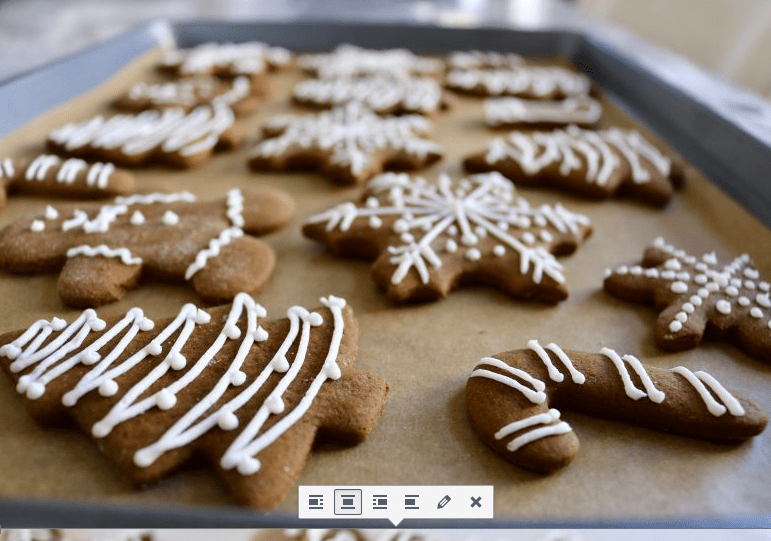Gluten-free Gingerbread Cookies
A traditional holiday favorite. Sweet, & spicy and, now, gluten-free
Ingredients
Cookies
- 3 cups Outrageous Baking all-purpose gluten-free flour mix
- 1 teaspoon baking soda
- 3/4 teaspoon ground cinnamon
- 3/4 teaspoon ground ginger
- 1/2 teaspoon ground allspice
- 1/2 teaspoon ground cloves
- 1/2 teaspoon salt
- 1/4 teaspoon freshly milled black pepper
- 8 tablespoons 1 stick unsalted butter, at room temperature
- 1/4 cup vegetable shortening at room temperature
- 1/2 cup packed light brown sugar
- 2/3 cup unsulfured molasses
- 1 large egg
Royal Icing
- 1 pound 4 1/2 cups confectioners' sugar
- 2 tablespoons dried egg-white powder
- 6 tablespoons water
Instructions
Cookies
- Position the oven racks in the top and bottom thirds of the oven and preheat to 350 degrees F.
- Sift the flour, baking soda, cinnamon, ginger, allspice, cloves, salt and pepper through a wire sieve into a medium bowl. Set aside.
- In a large bowl, using a hand-held electric mixer at high speed, beat the butter and vegetable shortening until well-combined, about 1 minute. Add the brown sugar and beat until the mixture is light in texture and color, about 2 minutes. Beat in the molasses and egg. Using a wooden spoon, gradually mix in the flour mixture to make a stiff dough. Divide the dough into two thick disks and wrap each disk in plastic wrap. Refrigerate until chilled, about 3 hours. (The dough can be prepared up to 2 days ahead.)
- To roll out the cookies, work with one disk at a time, keeping the other disk refrigerated. Remove the dough from the refrigerator and let stand at room temperature until just warm enough to roll out without cracking, about 10 minutes. (If the dough has been chilled for longer than 3 hours, it may need a few more minutes.) Place the dough on a lightly floured work surface and sprinkle the top of the dough with flour. Roll out the dough 1/8 inch thick, being sure that the dough isn't sticking to the work surface (run a long meal spatula or knife under the dough occasionally just to be sure, and dust the surface with more flour, if needed). For softer cookies, roll out slightly thicker. Using cookie cutters, cut out the cookies and transfer to nonstick cookie sheets, placing the cookies 1 inch apart. Gently knead the scraps together and form into another disk. Wrap and chill for 5 minutes before rolling out again to cut out more cookies.
- Bake, switching the positions of the cookies from top to bottom and back to front halfway through baking, until the edges of the cookies are set and crisp, 10 to 12 minutes. Cool on the sheets for 2 minutes, then transfer to wire cake racks to cool completely. Decorate with Royal Icing. (The cookies can be prepared up to 1 week ahead, stored in airtight containers at room temperature.)
Royal Icing
- Make ahead: The icing can prepared up to 2 days ahead, stored in an airtight container with a moist paper towel pressed directly on the icing surface, and refrigerated.
- This icing hardens into shiny white lines, and is used for piping decorations on gingerbread people or other cookies. Traditional royal icing uses raw egg whites, but I prefer dried egg-white powder, available at most supermarkets, to avoid any concern about uncooked egg whites.
- When using a pastry bag, practice your decorating skills before you ice the cookies. Just do a few trial runs to get the feel of the icing and the bag, piping the icing onto aluminum foil or wax paper. If you work quickly, you can use a metal spatula to scrape the test icing back into the batch.
- Dried egg-white powder is also available by mail order from The Baker's Catalogue, 1-800-827-6836. Meringue powder, which is dehydrated egg whites with sugar already added, also makes excellent royal icing; just follow the directions on the package. However, the plain unsweetened dried egg whites are more versatile, as they can be used in savory dishes, too. Meringue powder is available from Adventures in Cooking (1-800-305-1114) and The Baker's Catalogue.
- In a medium bowl, using a hand-held electric mixer at low speed, beat the confectioners' sugar, egg-white powder and water until combined. Increase the speed to high and beat, scraping down the sides of the bowl often, until very stiff, shiny and thick enough to pipe; 3 to 5 minutes. (The icing can be prepared up to 2 days ahead, stored in an airtight container with a moist paper towel pressed directly on the icing surface, and refrigerated.)
- To pipe line decorations, use a pastry bag fitted with a tube with a small writing tip about 1/8-inch wide, such as Ateco No. 7; it may be too difficult to squeeze the icing out of smaller tips. If necessary, thin the icing with a little warm water. To fill the pastry bag, fit it with the tube. Fold the top of the bag back to form a cuff and hold it in one hand. (Or, place the bag in a tall glass and fold the top back to form a cuff.) Using a rubber spatula, scoop the icing into the bag. Unfold the cuff and twist the top of the bag closed. Squeeze the icing down to fill the tube. Always practice first on a sheet of wax paper or aluminum foil to check the flow and consistency of the icing.
Notes
The dough must be chilled for at least three hours and up to two days. The cookies can be prepared up to one week ahead, stored in an airtight container at room temperature. I had to bake many batches to finally accomplish the perfect gingerbread cookie. When the dough is rolled thin, it will bake crisp and almost cracker-like. Yet, when rolled thick (my preference), the cookies turn out plump and moist. In either case, the flavor will be complex and almost hot-spicy.
Adapted from Food Network



